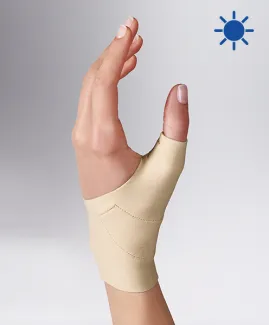Thumb arthritis is a degenerative disease of the trapeziometacarpal (TMC) joint located at the base of the thumb. Cartilage deteriorates, causing chronic pain, swelling and joint cracking. Gradually, the condition leads to loss of strength and thumb deformity in the most advanced cases.
Because of such disabling symptoms, people are struggling to work with arthritis in their hands. The consequences on the health of employees and the company are numerous. Now, discover the frequency, the causes, consequences and treatments for thumb arthritis at work with EPITACT®.
Struggling to work with arthritis in the hand: risky movements to avoid
Working with osteoarthritis in the hands is complicated because the movements that cause pain are frequent and sometimes unavoidable. Some risk factors are general: age, menopause, genetic predispositions, joint laxity, past traumas (fractures, sprains...), abnormality of the trapezium bone, etc.
Then, there are mechanical factors mainly related to the daily movements at work:
- Repetitive and rapid movements with the hand(1);
- Pinching objects between the thumb and the index finger;
- Carrying heavy objects;
- Hard working conditions (cold, humidity);
- Insufficient resting periods(1);
- Prolonged exposure to vibrations(1).
What are the worst jobs for arthritis in the thumb?
Regarding the aforementioned factors, a lot of people struggle to work with arthritis in the thumbs:
- Dress maker;
- Cabinet maker;
- Gardener;
- Pianist;
- Labour sector;
- Cotton work(2);
- Typist(2);
- Masseur, physiotherapist…
To resume, it includes all manual jobs that involve precise, repetitive and/or forceful movements. In general, people working on a computer and professional athletes who practise a racket sport are also affected. Indeed, all manual jobs can be considered to be aggravating or risk factors of thumb arthritis.
The impact of thumb arthritis on work and the company
Working with arthritis in the hands has mainly physical consequences because symptoms can be very painful and disabling. Joint pain becomes chronic and decreases the ability to realise daily movements. Indeed, pain reduces thumb abduction and so leads to muscle weakness and a loss of strength and dexterity. In addition to functional impairment, people struggling to work with arthritis in the hands can have a loss of concentration and difficulties performing their daily tasks.
Arthritis at work also impacts the company. For employers, the important thing is to reduce or limit the economic impact (sick leaves, compensations, loss of production...). To achieve this, it is essential to be informed and to put in place measures and arrangements to prevent this irreversible disease.
Working with arthritis in the thumb: treatment guidelines
Prevention
Preventing the pain or progression of thumb arthritis is key. Even if the condition is already there, the next advice can help to limit the worsening of symptoms. Think about avoiding twisting, repetitive, precise or forceful movements with your hand.
So, if you are struggling to work with arthritis, it is crucial to adapt the way you work and your workstation (you can ask an ergonomist for that). Limit the use of the computer mouse, try to keep your hand aligned with your forearm while typing on the keyboard for example, avoid using force or carrying objects with the tip of your fingers. Use ergonomic tools (anatomical scissors, bread knives, thick-handled tools...) that limit the stress on the TMC joint.
Thumb support braces
It is recommended to wear a thumb brace in the case of arthritis. This device helps the joint to rest and the thumb to be aligned with the forearm(3). To keep you active and relieve your symptoms of hand arthritis, EPITACT® has created two thumb braces. For mild arthritis, the flexible thumb support* helps to preserve range of motion while limiting the traumatic movements of your thumb while working. It contributes to ease pain and improves the hand’s function.
It is to use as a complement to the rigid thumb brace* that relieves basal thumb pain during resting periods and at night.
Both devices allow for continued relief of the symptoms of arthritis at work. By the way, the EULAR(3) recommends wearing a brace in the long term for the treatment of thumb arthritis (at least 3 months). And because this condition is chronic, our braces are very comfortable, thin and light to fit your daily life!
Other treatments
Thumb support braces are not the only option to help you continue working with arthritis. There is also the use of ergonomic tools and strengthening and range of motion exercises. Such exercises are realised with a physiotherapist and help to preserve the flexibility of the trapeziometacarpal joint.
The GP can also prescribe medications like painkillers, anti-inflammatory drugs and corticosteroid injections.
As a last resort, in the most advanced cases, surgery is recommended (cutting off the bone, removing the trapezium, inserting an implant...)
Consult a healthcare professional to receive the treatment the most appropriate to you and to the stage of your disease.
For people struggling to work with arthritis in the hands and thumbs, solutions exist. Unfortunately, the recognition of thumb arthritis as an occupational disease is still unclear and controversial.
*These solutions are class I medical devices that bear the CE marking under this regulation. Carefully read the instructions before use. Manufacturer: Millet Innovation. 09/2023
For more details about this general and simplified approach, here are further sources:
(1)Yucesoy B, Charles LE, Baker B, Burchfiel CM. Occupational and genetic risk factors for osteoarthritis: A review. Work. 2015;50(2):261‑73.
(2)Rogalev L, Scarfone S, Semere A. Rhizarthrose ou arthrose du pouce : une nouvelle maladie professionnelle ? Archives des Maladies Professionnelles et de l’Environnement. 1 mai 2018;79(3):360.
(3)Kloppenburg M, Kroon FP, Blanco FJ, Doherty M, Dziedzic KS, Greibrokk E, et al. 2018 update of the EULAR recommendations for the management of hand osteoarthritis. Annals of the Rheumatic Diseases. 1 jan 2019; 78(1):16‑‑ 24.
 Pharmacie
Pharmacie

